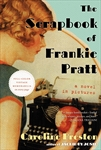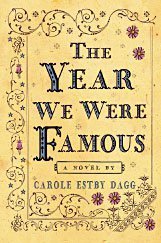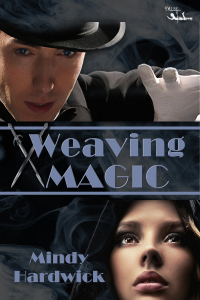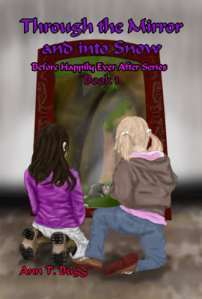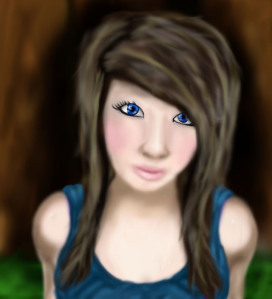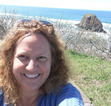Mindy Hardwick's Blog, page 56
March 9, 2012
Scrapbook of Frankie Pratt
I love books which push the boundaries of structure and form. So, I was thrilled to read The Scrapbook of Frankie Pratt by Caroline Preston.
The Scrapbook of Frankie Pratt by Caroline Preston is not only a novel about Frankie Pratt who wants to be a writer in the late 1920's, but the story is a work of scrapbook art! The book is a real scrapbook, made up of real stuff from the 1920's – letters, postcards, tickets, clippings, menus, fabric swatches, magazine covers, fashions spreads, candy wrappers, and sheet music – that author, Caroline Preston, cut up with scissors and pasted together with glue. Frankie Pratt's story is told by using a Smith Corona typewriter and pasting the words around the images.
You can see inside the book here
Caroline Preston lists some of the scrapbook items in the book and how and where she found them on her blog here.
She also writes about how she made the Scrapbook of Frankie Pratt here.
Recently, I inherited a box of old Valentines as well as a scrapbook of old cards—some dating back to the early 1900's. And guess what…I saw a couple of those old Valentines and cards that I inherited in the book!
The Scrapbook of Frankie Pratt is a feast for the creative spirit! I highly recommend it!








March 8, 2012
Write Your Own Fairy Tale
An upcoming class at Writers On the Net, "Write Your Own Fairy Tale" looks like it would provide some good material for those looking for a class. It's a five-week class and costs $200.
To register or find out more, check out the Writers on the Net Website
Write Your Own Fairy Tale (5 weeks)
Have you ever wanted to go back and edit the script of your life — or even just a segment of it? Got imagination? What would it look like if you envisioned your own story as a "happily ever after" or at least a more powerful version of what may, in fact, only appear as "real"? In retelling our own lifes as myths and fairy tales – our beginnings, environment, family and past choices – might we become stronger, more capable or at least more at peace?
Fairy tales enable us to pass through the dark and shadowy, even frightening times and transitions of our lives. They make us aware of the unseen and are fodder for our personal growth. They are fertilizer for our dreams. We'll follow the imagination of great fairy tale writers like Hans Christian Andersen and C.S. Lewis, and peer into the traditions of Original Peoples to re-imagine, re-shape or embellish our so-called "real" stories. We'll look at the work of Clarissa Estes, author of Women Who Run with the Wolves, to inspire us to dare our way forward. She says, "stories are medicine." How might your life stories, as grist for your mill, be reframed to give you healing, courage or faith?
Class Outline
Week 1: Re-Frame a Story in Many colors.
Are you bewildered, but brave? In this class, you'll find yourself wearing the Ruby slippers and flourishing a writing pen. Together, we learn to recognize fairy tales that have influenced us, see personal archetypes present in myth and folklore. We begin to write from our own mythic imagination/ emotion.
Week 2: Embrace Your Shadow Side.
Every story has a "problem." (No problem, no story.) What's less-than, hurting, dark, or menacing in your story? Of what are you most fearful? Who is your villain? What sinister characters do you meet on the yellow brick road? In what divergent ways might you respond? Find out as you write yourself forward.
Week 3: Shed New Light on It
Your story will be influenced by the quality of the light in your picture. As the light changes, so does the way you see. Images may shift from murky to textured, to magical or mystical. In darkness, infrared photographic "filters" induce night-vision illumination. Are you looking deep, deeper, deepest?
Week 4: Become the Hero of Your Own Life.
How will you engage your heroic moment? Once you commit, you experience things that otherwise never would occur. What ups-and- downs unfold to test your dreams and intentions? Casting fears aside, use the climax to see yourself in an entirely new way, or merely tweak the past to vitalize your dreams.
Week 5: Write a renewed "ever-after".
Complete your story; it is your gift to yourself. How did chance, or destiny, play a part in your fairy tale? In what ways did you enable your own heroic ever-after? What symbol or archetype has arisen for you? How might you enable a stream of wisdom/healing to flow through you in other fairy tales?








March 5, 2012
Stained Glass Summer Updates
I wanted to take a little bit of time and share some updates on Stained Glass Summer.
1. Stained Glass Summer is now distributed through Baker and Taylor and is available for libraries! Yea!!! The same will also be true of YA Romance, Weaving Magic. (Release April 27, 2012).
2. Stained Glass Summer is 25% off at Smashwords this week in honor of Read an E-Book Week. Smashwords sells books in all formats–Kindle, Nook, Ipad, Iphone, etc. So if you haven't had a chance to read Stained Glass Summer, this is a great time to take advantage of the sale! The e-book is only on sale through Smashwords, and you must use the coupon code which is listed on the Smashwords book page for Stained Glass Summer here. REW25
3. Stained Glass Summer has gotten some great reviews on Goodreads as well as Amazon. Thanks to everyone who has posted reviews! If you've read the book, reviews are always appreciated!
3. This week, I'm a guest blogger on June Kramin's blog talking about the title of Stained Glass Summer. I interviewed June's daughter Valerie Kramin about her art a few weeks ago here.
You can read the interview about the title of Stained Glass Summer here.
4). I've listed all the blog interviews and guest posts for Stained Glass Summer on the book page on my website. The posts are all listed under the excerpt on the book page. Blog posts include everything from interviews with my mentee to cooking dishwasher fish to character interviews.
Whew! I think that's it on the round-up of recent news about Stained Glass Summer!








March 2, 2012
Girls, Baseball and Batter Up! Writing Contest
Are you a student in grades sixth, seventh, or eighth in the US or Canada? Then check out this great Writing Contest! Batter Up! The Contest is sponsored by the All-American Girls Professional Baseball League.
Write a short essay that answers one of these three questions:
Why was the AAGPBL important to the history of girls and women in the United States and Canada?
Why do you think it's important that people remember the All-American Girls Professional Baseball League years from now?
Which All-American Girls Professional Baseball League player (living or dead) do you wish you could meet, and why?
Your essay should be between 500-700 words, and you must submit using this form here
Entries are due on March 18, 2012.
To find out more, go to the All-American Girls Professional League Baseball Contest Rules here.
And if you want to read a little more about Girls in Baseball, check out Diamond Ruby by Joseph Wallace. Diamond Ruby is the story of seventeen year old Ruby who after losing her parents in the Influenza Flu of 1918, has to figure out a way to keep her two cousins, Amanda and Allie, her drunk brother, Nick, and herself alive. Ruby is blessed with a long arm and the ability to pitch baseball.It is 1923, and the Cony Island Boardwalk has just opened. Ruby is hired to work as a side-show pitching balls. It is here that she catches the attention of both Babe Ruth and the Klu Klux Klan as well as the Rum-Runners of the 1920′s.
And here is a handout, Where Are The Girls in Baseball, I made to go with the book which explores some facts about Girls in Baseball such as:
In the late 1890's, mixed gender teams appeared and were called The Bloomer Girls. These teams lasted until the 1930's. Bloomer Girls wore bloomers and were predominately working class. There were usually six to seven women on a team with two to three men who dressed as women. The pay was significant for the men to dress as women, and some men used the experience as stepping stones to successful careers in men's baseball. Although women could play on these teams, they could not advance to the minor or major leagues. By the 1900's, the women ditched the bloomers and were playing in men's baseball attire.
There were no professional women's baseball teams for over thirty-five years, even though Title IX was enacted in 1972. In 1984, Bob Hope tried to start a team of women's baseball players, The Florida Sun Sox. He hoped the team would compete against the male teams. The team received very little support from sports journalists, other baseball players, and officials. The women proved they could play at try-outs, but the franchise was denied. Hope tried again in 1993 with a team called The Colorado Bullets. Most of the team had attended college on softball scholarship and were not used to curveballs, sliders and sinkers, or hitting with lighter aluminum bats. The first season's record was poor with very little fan support. The team lasted until the 1996-97 season when Coors announced it would no longer sponsor them.








March 1, 2012
Woman's History Month
March is Women's History Month, and the theme this year is Women's Education Women's Empowerment.
You can read more about the the theme here.
The Kidlit Community celebrates Women's History Month with an outstanding blog. The blog includes guest posts from children's authors as well as those who blog in the children's literature world. I would highly recommend subscribing to the Kidlit Community Women's History Month Blog. It's a treat everyday in your e-mail or blog reader.
You can find out more about the blog here.
In honor of Women's History Month, I'd like to give a special shout-out to young adult author, Carole Estby Dagg, for her outstanding book, The Year We Were Famous.
Carole's story, The Year We Were Famous, begins in Mica Creek, Washington when the family home faces foreclosure, and seventeen-year-old Clara Estby and her mother, Helga, need to raise a lot of money fast—no easy feat for two women in 1896. Helga wants to tackle the problem with her usual loud and flashy style, while Clara favors a less showy approach. Together they come up with a plan to walk the 4,600 miles from Mica Creek, Washington, to New York City—and if they can do it in only seven months, a publisher has agreed to give them $10,000. The story is based on the true story of Carole's great-aunt and great-grandmother. The historical adventure is set during the time of the suffragist movement, the 1896 presidential campaign, and the changing perception of "a woman's place" in society.
There is a great interview with Carole about the process of writing the book at Authorlink.
In the interview, it is mentioned that Carole's manuscript was rejected 29 times, and when asked: How did you stay motivated? Why didn't you give up? Did you revise after every rejection? She responded: I took each rejection as a sign I wasn't ready yet, took more classes and workshops, revised, and submitted again. I became so obsessed with getting it right that I quit my job as assistant director of Everett Public Library to spend more time researching and rewriting. I didn't inherit Clara and Helga's physical endurance, but I guess I did inherit the stubborn Norwegian persistence gene.
That endurance paid off and The Year We Were Famous was a winner of the SCBWI Sue Alexandra Award for Most Promising New Manuscript.
There is a ton of great information about The Year We Were Famous on Carole's website here.
Carole also wrote a great blog post about using "old school props" in her author talks. You can read that blog interview here.
The Year We Were Famous is a great book to read to celebrate Women's History Month, and it's a great book for bookgroups. It's my choice in the Women's Bookclub this month, and I'm very excited to have Carole coming to talk to our group about her book.








February 29, 2012
Tag Your Favorite Author's Books
There are a lot of ways you can help your favorite author. Buy their books. Recommend their books. But, you can also do something very simple–tag your favorite author's books.
What is "tagging" your favorite author's books?
Tags are the key words that are used to search for a book or topic. They are the key words, themes, and ideas found in a book. For example, the tags for Stained Glass Summer are:
Art, Coming-of-Age, Middle Grade, Stained Glass, Contemporary, Glass Art, Arts, Mentor, and Mindy Hardwick.
Where can you find these tags? On Amazon, the tags are listed in the middle of the book's buy page. So, if you scroll down half-way on the Stained Glass Summer page, you will see a list of "tags" or key words. There are little numbers in parenthesis by the words and that means others have clicked on the words (Tagged the words), and those numbers show how many people have clicked on those tags.
Why are tags important? Tags help a book rise in the search engines. If someone is searching for mentoring, Stained Glass Summer will rise to the top of the search list if those little tags have been clicked enough times.
These days, selling a book, has a lot to do with technology!
So, if you'd like to try "Tagging a Book" head on over to the Stained Glass Summer page here, and scroll to the middle of the page, then click on each of those words. Viola. Tagging is done!
And your favorite author will be very grateful!








February 28, 2012
Contemporary Romance Short Story Published
I'm happy to report, that my contemporary adult romance short story, Love's Storms, is now available to purchase at Amazon.
For the first ninety days, the story is a part of Amazon's Lending Library, so if you have Amazon Prime, you can read the story for free as your lending title of the month. If not, it's only 99 cents.
Here is the blurb for Love's Storms.
Smart and savvy Sabrina runs a small bed and breakfast in Western New York, and is doing everything she can to risk falling in love again. Meanwhile, sexy and successful Damon has the world at his doorstep–except for the one woman he's never forgotten, Sabrina, his first love. When the town hosts a Sailing Regatta, Damon shows up at Sabrina's Bed and Breakfast as one of the crew in the race. But, surrendering to love is not easy, and it will take a storm to show both Sabrina and Damon that some things are worth holding onto.
So, how did I end up publishing an adult short story romance when I write in the children's market? It all started with my upcoming YA romance, Weaving Magic.
In my upcoming YA romance, Weaving Magic, main character Shantel loves romance. When I wrote Weaving Magic, some of my research included learning about romance books. The first place I started was by attending some of the Seattle Romance Writers of America Meetings and Conferences. I got a big stack of local author's books and I started to read.
The first thing I discovered is there are many levels of romance. There are historical, paranormal, and contemporary. There are category romances such as the books found in the Harlequin Lines of Love Inspired (Spiritual/Inspirational), and Harlequin Blaze. (Hot, sexy books). There are single title romances such as those by Nora Roberts, Susan Wiggs, and Susan Mallery. And there are short stories and novellas.
I bought my first e-reader after hearing e-publisher editor Angela James speak at the Seattle Romance Writers Conference.
Romance has changed a lot since the days of bodice rippers and passive women. Today's romance heroine is most likely to be strong, empowered, and smart. She meets a man who is her equal and then it's a dance of learning to surrender to each other. My favorite question in writing romance is: Why is she the wrong woman for him? And why is he the wrong man for her? But, yet, they come together! And that's what makes the story!
After all of that learning about romance, I sat down to write a few myself. I immediately loved the short form–novellas and short stories. I'm a children's writer at heart, and short just comes naturally to me!
A couple of my romance short stories were published on e-zines, and then I found a romance publisher who was looking for short stories to publish as e-books.
I sent off my contemporary romance (Sweet Level), and today, I'm happy to report, that the story, Love's Storms, is now available to purchase at Amazon.
Enjoy!








February 24, 2012
Cover Art for Weaving Magic
It's time to reveal cover art for YA romance, Weaving Magic. (Forthcoming April 27, 2012). I'm absolutely thrilled with this cover!








Picture Book Workshop Resources
The following are handouts and references for the Writing the Picture Book Workshop at the Tolovana Community Hall in Cannon Beach, Oregon. If you click on the link, it will take you to the resource.
Resources for the Picture Book Writer Handout
Where the Wild Things Are Exercise
Other Useful Resources
Carla Sonheim's Mixed Media Drawing Book
Carla Sonheim's Classes-She runs the Silly Class which I talked about. This is the class where each morning, we receive a short (ten minute or less), fun and silly drawing assignment to do via our e-mail. I participated in her January class and loved it!
Carla Sonheim Interview–I interviewed Carla about mentoring. It was posted on my blog in January.
Writing the Picture Book for Educators--This is the class I teach through Seattle Pacific University for Educators. You'll need to look under the category of Reading, Writing and Communications. This is a year-long distance learning class that you complete at your own pace. Educators earn five continuing education classes. A great way to work on your picture book and get feedback from me!
Helpful Blog Posts About Picture Book Writing
Story Structure for Picture Books
Targeting Your Picture Book Submission








February 21, 2012
Teen Artist Valerie Kramin Blog Interview
Today, I'm happy to have teen artist, Valerie Kramin on the blog! I was introduced to Valerie's work through her Mom, June Kramin. June's recent book, Hunter's Find is a mystery suspense published by Musa Publishing.
When I asked Valerie to tell us a little bit about herself, she said this: "I was born in northern Minnesota in a car the middle of a snow storm. I live out in the middle of nowhere, so in my boredom I joined a site called DeviantArt about a year and a half ago. I made friends from all over the world. I'm not into sports but I do get involved in school plays. Dragons are my thing. Currently I'm getting a Dungeons and Dragon club started up at my school."
Thanks for joining us today, Valerie!
One of the things which interested me about Valerie is she got to create the book covers for Ann T Bugg's middle grade series, Before Happily Ever After. I asked her about that process:
First, I read the story. Then I listen to what the author wants, (Ann T Bugg is the pen name for Valerie's Mom, June Kramin) write it down, lose the note, and just wing it. The most important stage is finding music. Without music I cannot draw. I make tons of sketches, like if you took all of them and put them end to end, you could probably make a bridge to the moon. The only thing is that I usually throw them all out, but eventually I sketch one I like. And finally, the painting. I use Photoshop and my drawing pad to paint, and that allows me to paint lots and lots of layers (to make it more realistic). So for about a week or so I do nothing but make careful brushstrokes and smudge it to try to make it look more like a picture than a drawing.
What type of art classes have you taken?
Actually, not that much. At my school we only have basic arts, so that's drawing in a cartoon style, paper Mache, pottery, and photography. I'm mostly self-taught (with some help of YouTube and some friends on DeviantArt)
Do you have an art mentor? (I loved what Valerie had to say about her Muse)
Mrs. Isfield is my school art teacher, so I guess she could be counted. She doesn't teach me anything with digital drawing though, just paper and clay art.
Also there is Muse (no, not the band). Muse is what I call my imaginary fox-like creature that follows me all around. She tells me to do some new things, try forgetting to do a random step, and gives me inspiration. Preferably I would want a dragon muse, but noooooo….
Have you entered art contests? How did you place?
Not any official ones, but there are quite a few contests on the DeviantArt site. I've entered dozens but haven't won any of them.
Oh wait, there were a few art contests at school that I've entered. I've got first place for a painting of Muse, and second place for a clay squirrel (which got stolen sadly…).
What do you find the most challenging about creating art?
Mainly, coming up with something original. Of course you don't always need to be original, but if you want to make a rainbow dog with three scarves and a chain on it, someone is going to pop up and say "Hey that looks just like so-and-so's character!" and it's not a good feeling.
What do you find the easiest about creating art?
Expressing myself. If something is bugging me, I can just draw about it and it takes almost all of the stress away.
Imagine yourself ten years from now? What will you be doing artistically?
I plan on going to Full Sail University in Florida. It specializes in video game programing, fine art, animation and so much more. A lot of Pixar graduates come from there. I would love to get hired by a company that does character design for video games or something along those lines.
But, in my dream future, I will be in outer space drawing a mini comic series for the aliens that are from a planet that has a purple sky and has red grass, and they speak a very confusing language so I usually have lots of computers around helping me translate. I have a pet super albino robot dragon that has the name of Roy, and Gravity-defying fox that sits on my head. And it turns out I'm actually a princess from a different world, and I have super powers.
Yeah… I like that a lot more…
Here is one of Valerie's art pieces on Deviant Art.
If you'd like to learn more and connect with Valerie, please visit:









